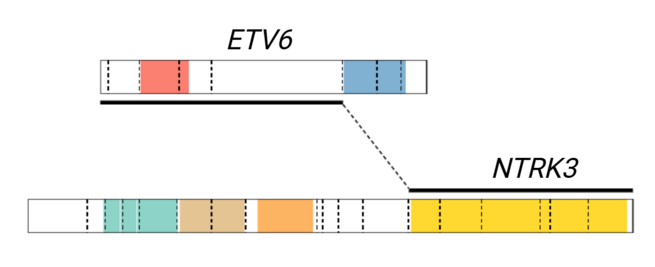Secretory carcinoma
Breast Tumours (WHO Classification, 5th ed.)
Primary Author(s)*
Hui Chen, MD, PhD, The University of Texas MD Anderson Cancer Center, Houston, TX, USA
Katherine Geiersbach, MD, Mayo Clinic - Rochester, MN, USA
WHO Classification of Disease
| Structure | Disease |
|---|---|
| Book | Breast Tumours (5th ed.) |
| Category | Epithelial tumours of the breast |
| Family | Rare and salivary gland-type tumours: Introduction |
| Type | Secretory carcinoma |
| Subtype(s) | N/A |
WHO Essential and Desirable Genetic Diagnostic Criteria
| WHO Essential Criteria (Genetics)* | |
| WHO Desirable Criteria (Genetics)* | ETV6::NTRK3 fusion |
| Other Classification |
*Note: These are only the genetic/genomic criteria. Additional diagnostic criteria can be found in the WHO Classification of Tumours.
Related Terminology
| Acceptable | |
| Not Recommended |
Gene Rearrangements
| Driver Gene | Fusion(s) and Common Partner Genes | Molecular Pathogenesis | Typical Chromosomal Alteration(s) | Prevalence -Common >20%, Recurrent 5-20% or Rare <5% (Disease) | Diagnostic, Prognostic, and Therapeutic Significance - D, P, T | Established Clinical Significance Per Guidelines - Yes or No (Source) | Clinical Relevance Details/Other Notes |
|---|---|---|---|---|---|---|---|
| NTRK3 | ETV6::NTRK3[1] | Fusion results in constitutive activation of NTRK3 tyrosine kinase | t(12;15)(p13;q25) | Common | D, P, T | The ETV6::NTRK3 fusion is diagnostic of secretory carcinoma in the appropriate morphologic and clinical context.[2][3][4] This fusion is responsive to TRK inhibitor therapies such as larotrectinib abd entrectinib. | |
Individual Region Genomic Gain/Loss/LOH
| Chr # | Gain, Loss, Amp, LOH | Minimal Region Cytoband and/or Genomic Coordinates [Genome Build; Size] | Relevant Gene(s) | Diagnostic, Prognostic, and Therapeutic Significance - D, P, T | Established Clinical Significance Per Guidelines - Yes or No (Source) | Clinical Relevance Details/Other Notes |
|---|---|---|---|---|---|---|
Characteristic Chromosomal or Other Global Mutational Patterns
| Chromosomal Pattern | Molecular Pathogenesis | Prevalence -
Common >20%, Recurrent 5-20% or Rare <5% (Disease) |
Diagnostic, Prognostic, and Therapeutic Significance - D, P, T | Established Clinical Significance Per Guidelines - Yes or No (Source) | Clinical Relevance Details/Other Notes |
|---|---|---|---|---|---|
Gene Mutations (SNV/INDEL)
| Gene | Genetic Alteration | Tumor Suppressor Gene, Oncogene, Other | Prevalence -
Common >20%, Recurrent 5-20% or Rare <5% (Disease) |
Diagnostic, Prognostic, and Therapeutic Significance - D, P, T | Established Clinical Significance Per Guidelines - Yes or No (Source) | Clinical Relevance Details/Other Notes |
|---|---|---|---|---|---|---|
Note: A more extensive list of mutations can be found in cBioportal, COSMIC, and/or other databases. When applicable, gene-specific pages within the CCGA site directly link to pertinent external content.
Epigenomic Alterations
Genes and Main Pathways Involved
| Gene; Genetic Alteration | Pathway | Pathophysiologic Outcome |
|---|---|---|
| NTRK3; Activating fusion with 5' partner ETV6 | MAPK/PI3K/AKT signaling | Increased cell growth and proliferation |
Genetic Diagnostic Testing Methods
FISH, RT-PCR, next generation sequencing
Familial Forms
None
Additional Information
Links
https://www.pathologyoutlines.com/topic/breastmalignantjuvenile.html
Notes
Prior Author(s):
References
- ↑ Tognon, Cristina; et al. (2002-11). "Expression of the ETV6-NTRK3 gene fusion as a primary event in human secretory breast carcinoma". Cancer Cell. 2 (5): 367–376. doi:10.1016/s1535-6108(02)00180-0. ISSN 1535-6108. PMID 12450792. Check date values in:
|date=(help) - ↑ Arce, C.; et al. (2005-06-17). "Secretory carcinoma of the breast containing the ETV6-NTRK3 fusion gene in a male: case report and review of the literature". World Journal of Surgical Oncology. 3: 35. doi:10.1186/1477-7819-3-35. ISSN 1477-7819. PMC 1184104. PMID 15963235.
- ↑ Jacob, John Doromal; et al. (2016-06). "Rare breast cancer: 246 invasive secretory carcinomas from the National Cancer Data Base". Journal of Surgical Oncology. 113 (7): 721–725. doi:10.1002/jso.24241. ISSN 1096-9098. PMID 27040042. Check date values in:
|date=(help) - ↑ Li, Dali; et al. (2012-04). "Secretory breast carcinoma: a clinicopathological and immunophenotypic study of 15 cases with a review of the literature". Modern Pathology: An Official Journal of the United States and Canadian Academy of Pathology, Inc. 25 (4): 567–575. doi:10.1038/modpathol.2011.190. ISSN 1530-0285. PMID 22157932. Check date values in:
|date=(help)
*Citation of this Page: “Secretory carcinoma”. Compendium of Cancer Genome Aberrations (CCGA), Cancer Genomics Consortium (CGC), updated 04/16/2025, https://ccga.io/index.php/BRST5:Secretory carcinoma.
